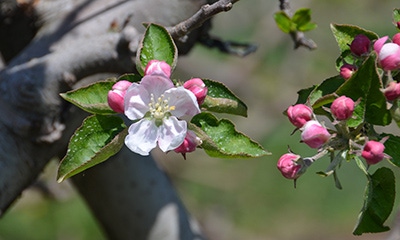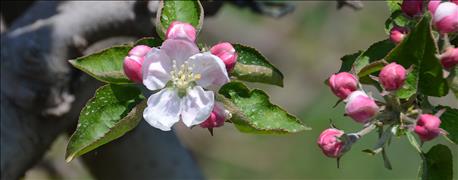February 22, 2016

The 2015 U.S. apple crop was driven significantly lower driven by a much smaller crop out West – down nearly 20% compared to 2014. It was due to the long window of high temperature summer days that affected yields and fruit quality in Washington State. The high temperatures negatively impacted all varieties, but hit Gala and Fuji hardest.
Related: Land price outlook: Northeast land value uptick may be slowing
Eastern production, notably New York and Michigan, was up overall. That’s why, compared to 2014, fruit destined for fresh markets led to higher prices for fresh and processed fruit in the East.

APPLES ON THE VINE? Not quite. But training modern apple varieties to produce on high-density trellis systems is one of the labor- and cost-saving technologies being used by growers.
It’s widely expected that we’ll see a much larger U.S. apple crop in 2016 relative to 2015, given a normal growing season in various regions. Over the past decade or so, apple prices received by producers have been relatively strong. While large apple crops will place pressure on fruit prices for growers, industry experts maintain optimism for apple prices and producer income going forward for three reasons:
* Apple marketers are expected to continue to be successful at demanding strong fruit prices.
* We see renewed interest in export markets for U.S. apples, notably from Washington State. The recent Trans-Pacific Partnership trade talks are expected to increase export opportunities to key regions in the Pacific Rim.
* Producers and marketers are carefully considering introduction of various patented apple varieties to U.S. consumers. These patented varieties command premium prices. Such varieties are expected to generate additional consumer enthusiasm in the fresh apple market.
Related: Dairy outlook: Pump the brakes on milk expansion

BRAD RICKARD
At this point, it’s not clear whether these new varieties will replace consumption of older, more traditional, varieties, or if they’ll expand total U.S. apple demand and lift per capita consumption rates. Early indications are that both of these market phenomena will occur.
Labor remains #1 issue
The number one issue facing U.S. apple producers in 2016 will be labor. This includes the on-going questions about the supply of labor available to manage orchards and pick fruit, as well as the implications of possible minimum wage increases. All this is pushing producers toward mechanization and other labor-saving technologies.
~~~PAGE_BREAK_HERE~~~
Farmers managing labor-intensive specialty crop operations must cope with major risk and uncertainty associated with the perennial challenges of hiring a legally authorized and reliable workforce. This, in an exceptionally challenging, seemingly intransigent immigration policy, regulatory and enforcement environment.
Related: Corn and soybean outlook: Corn and soybean market hopes lean on exports
Aside from supporting continuing, yet so far fruitless political initiatives to reform current federal policy, many farmers are experimenting with practices to manage such labor risks. Already in 2016, we’ve witnessed renewed discussions about increasing the minimum wage to $15 per hour.
Given that labor represents 30% to 50% of total costs for most fruit farms – approximately 40% for apple farms, any increase in the minimum wage rate will impact labor markets in various ways. It’ll have a non-trivial effect on total labor costs for fruit farms.
Questions about labor availability and potential increases in the minimum wage are sure to foster additional discussions in 2016 and beyond about the feasibility of new labor-saving technologies in perennial fruit crop industries (e.g., platform harvesters). It’s certain to move larger producers in that direction.
Rickard is a Cornell ag economists specializing in fruit economics.
This is part of American Agriculturist’s exclusive 2016 Northeast Ag Outlook series, courtesy of Cornell and Penn State universities. Tomorrow’s segment will focus on the small fruit outlook.
You May Also Like




